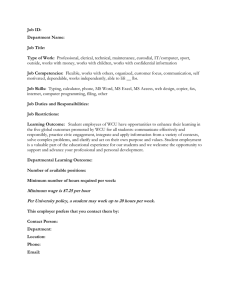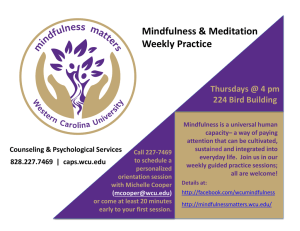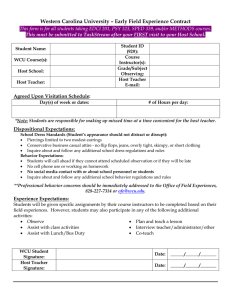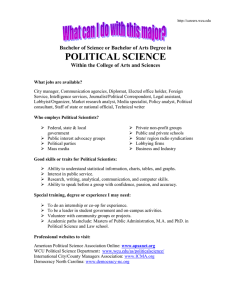Consultant Report Western Carolina University Potential Solutions and Opportunities:
advertisement
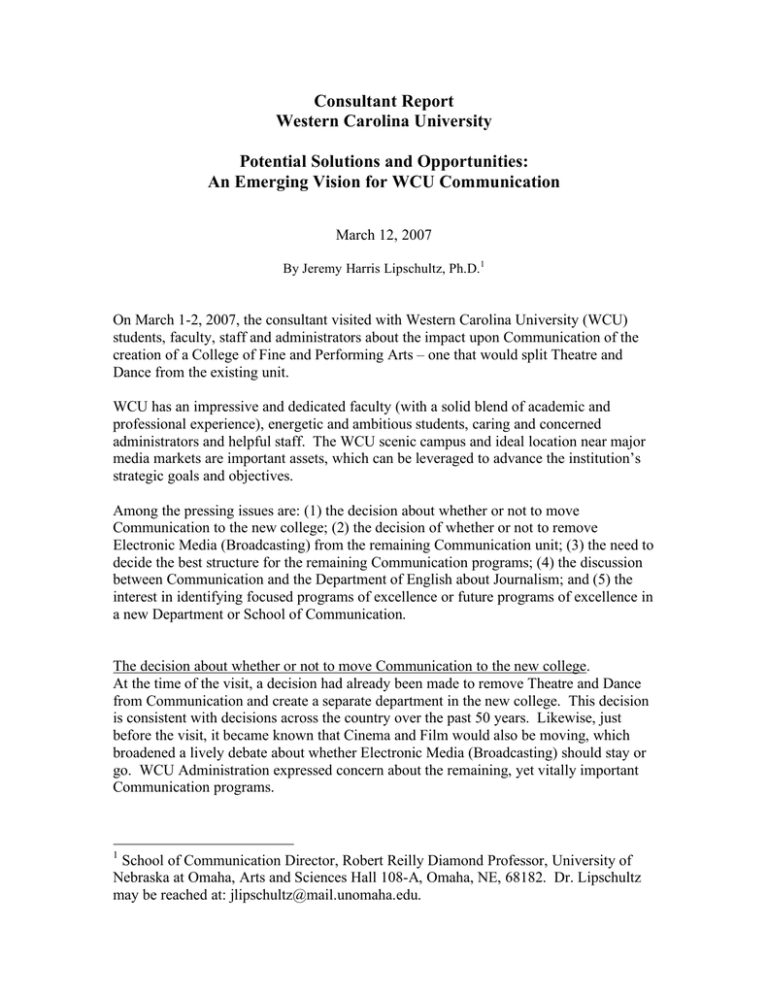
Consultant Report Western Carolina University Potential Solutions and Opportunities: An Emerging Vision for WCU Communication March 12, 2007 By Jeremy Harris Lipschultz, Ph.D.1 On March 1-2, 2007, the consultant visited with Western Carolina University (WCU) students, faculty, staff and administrators about the impact upon Communication of the creation of a College of Fine and Performing Arts – one that would split Theatre and Dance from the existing unit. WCU has an impressive and dedicated faculty (with a solid blend of academic and professional experience), energetic and ambitious students, caring and concerned administrators and helpful staff. The WCU scenic campus and ideal location near major media markets are important assets, which can be leveraged to advance the institution’s strategic goals and objectives. Among the pressing issues are: (1) the decision about whether or not to move Communication to the new college; (2) the decision of whether or not to remove Electronic Media (Broadcasting) from the remaining Communication unit; (3) the need to decide the best structure for the remaining Communication programs; (4) the discussion between Communication and the Department of English about Journalism; and (5) the interest in identifying focused programs of excellence or future programs of excellence in a new Department or School of Communication. The decision about whether or not to move Communication to the new college. At the time of the visit, a decision had already been made to remove Theatre and Dance from Communication and create a separate department in the new college. This decision is consistent with decisions across the country over the past 50 years. Likewise, just before the visit, it became known that Cinema and Film would also be moving, which broadened a lively debate about whether Electronic Media (Broadcasting) should stay or go. WCU Administration expressed concern about the remaining, yet vitally important Communication programs. 1 School of Communication Director, Robert Reilly Diamond Professor, University of Nebraska at Omaha, Arts and Sciences Hall 108-A, Omaha, NE, 68182. Dr. Lipschultz may be reached at: jlipschultz@mail.unomaha.edu. In the best of all worlds, the consultant believes that a more complete dialogue about the future of all units should have been engaged following the October, 2005 recommendations from Communication faculty in the affected areas.2 The current plan attempts to address concerns that the department is “too large and too diverse to manage effectively,” that “resources are spread too thin,” that “department-wide meetings” are “difficult to hold,” that the “department has only one secretary,” and that “the wide range of programs” has produced recruitment problems.3 The faculty report, however, neither effectively addressed peer institutions nor offered creative solutions. There are many examples across the country of large and complex programs that work more effectively as a team. Nevertheless, the structural proposals that included either creation of a College of Communications and Theatre Arts or School of Communications and Theatre Arts, while too narrow, offered a basis for review of peer institutions. East Carolina University’s College of Fine Arts and Communication has been studied by others and considered a model structure.4 This college includes Schools of Art and Design, Communication, Music, and Theatre and Dance.5 Likewise, the University of Memphis has created a College of Communication and Fine Arts that houses Art, Communication, Journalism, and Theatre and Dance departments and the Rudi E. Scheidt School of Music. The unit is also home to an art museum and an Institute of Egyptian Art and Archeology.6 More recently, the consultant’s institution, the University of Nebraska at Omaha, created a College of Communication, Fine Arts and Media. It includes a new School of Communication, a departments of Art and Art History, a Department of Theatre, a Writer’s Workshop, KVNO-FM and UNO Television.7 Each university broke from the status quo in bold moves to produce exciting, creative and collaborative initiatives. The winners are the students who are being prepared to enter what economist Richard Florida has dubbed the “Creative Class.”8 The WCU faculty document proposed creating four departments within a new college: • • • • Communication Studies Broadcasting and Motion Picture Studies Journalism, Public Relations and Advertising Theatre and Dance 2 Reorganization Recommendations: Department of Communication, Theatre and Dance, October 10, 2005. 3 Ibid. p. 1. 4 http://www.ecu.edu/artscomm/ 5 http://www.ecu.edu/cs-cfac/about.cfm 6 http://ccfa.memphis.edu/departments.htm 7 http://www.unomaha.edu/cfam/ 8 http://www.creativeclass.org/ 2 While resources may not have existed to departmentalize each of these four areas, the organization reflected a valuable emerging vision for WCU. The consultant favors a more integrated approach to Communication, but local concerns may have steered the document in this direction. Faculty viewed the current structure as a “burden of being buried within a large cumbersome department.”9 In point of fact, size is not as important as effective communication, leadership and cultivation of a team spirit. Clearly, one can find many examples of the four areas organized as separate departments. While the historic trend across the country has been to separate Theatre and Dance from Communication, there also are many examples in which Broadcasting and Journalism have been combined into Mass Communication units. Thus, faculty and administrators might have negotiated an ideal structure for a new college. However, an outside committee instead did the heavy lifting, and Communication faculty members expressed feelings of frustration over being left out. Still, there also was more that the department could have done during this period to proactively engage the campus in a discussion. That being said, WCU must move forward. Communication faculty – during an important stretch of months that continues at this writing – have lacked appropriate leadership, and frequently failed to meet to help strategize their potential options. WCU, thus, did not seize the opportunity to create a forward-looking college (i.e. College of Communication & Fine and Performing Arts). It is unclear to the consultant whether or not this door has closed. However, given that Communication faculty in their document articulated long-standing connections with Theatre, there is good reason to give this option further consideration in an open and deliberative fashion. The decision of whether or not to remove Electronic Media (Broadcasting) from the remaining Communication unit. Regardless of whether or not Communication moves or stays, there was strong consensus by Communication faculty that Electronic Media (Broadcasting), which has thrived and grown into a major program, should remain with colleagues in Communication. The decision to move Cinema and Film did not create a constructive environment for faculty input. Further, Communication faculty members do not hold in high regard the current direction of Cinema and Film. Beyond these reasons, there are exciting opportunities offered in the area of Convergence Journalism, Interactive and New Media – these must include Broadcasting. 9 Supra. Fn. 1, p. 2. 3 The need to decide the best structure for the remaining Communication programs. Given the size and complexity of the remaining unit, as well as the need to strengthen Convergence Journalism and Interactive/New Media, the consultant recommends that WCU strongly consider the establishment of a School of Communication. Such a structure would place WCU among peers with professionally oriented programs across the county. A School of Communication should have a director and assistant director, a full-time academic advisor and two staff assistants. There are additional needs for support staff – especially in the area of broadcast engineering. A School would retain the remaining areas left by the departure of Theatre and Dance. The discussion between Communication and the Department of English about Journalism. The Department of English appears to be misguided in its contention that professional journalists come from English majors: “High school writers look for Journalism when they go to college, and they look for it in the English department… Most truly professional writers were English majors.”10 This view reflects an old model that existed prior to the development of Journalism departments, schools and colleges during the past 50 years. The establishment of the Association for Education in Journalism and Mass Communication (AEJMC) with 3,500 members around the world,11 the development of doctoral degree programs in Journalism and the insistence of the industry that Journalism programs meet the rapidly changing industry forces led to a decline in the previously popular English programs. Further, the existing WCU courses do not address Convergence Journalism, which will eventually push news to exclusively online sites – the PBS Frontline investigation “News War” should be reviewed by faculty members in this area.12 It is also suggested that WCU send a delegation of faculty members from all areas to “A Showcase of Convergent Media Projects and Practices,” hosted by the University of South Carolina (USC), October 11-13, 2007. USC also holds valuable Newsplex Summer Seminars and produces a monthly Convergence Newsletter.13 WCU is not fully meeting the needs of Journalism students because there is no daily newspaper and online site that would force students to adhere to daily deadlines. Instead, the Western Carolinian news magazine, while offering a limited writing experience for students, does not adhere to professional standards of journalism.14 10 Elizabeth Addison, English Department Head, March 2, 2007. http://aejmc.org/ 12 http://www.pbs.org/wgbh/pages/frontline/newswar/ 13 http://www.jour.sc.edu/news/convergence/ 14 Western Carolinian news magazine, 71(10), Feb. 23-Mar. 22, 2007. 11 4 A Convergence Journalism program must reside in Journalism because the multimedia products produced will involve not only text editing, but also audio and visual communication. English should limit its involvement to writing and editing courses that focus on grammar, punctuation, spelling and style. WCU needs an entrance course that certifies the writing and editing skills of its Journalism and all Communication majors. Communication should have the exclusive responsibility to address the advanced instructional needs of students wishing to become professional journalists. The interest in identifying focused programs of excellence or future programs of excellence in a new Department or School of Communication. 1. Electronic Media. There is no question that the Electronic Media (Broadcasting) degree program is the existing primary program of excellence in Communication. Radio students routinely go directly from WCU to large media markets, which is extremely rare in programs across the country. The reason is simple: WCU has rapidly established a radio station that adheres to the strictest professional norms, and students are prepared to work at a high level. Likewise, the industry is clamoring for WCU Broadcast Sales graduates. The consultant was impressed that faculty members travel with students to the annual meeting of the Broadcast Education Association (BEA) and National Association of Broadcasters. Students gain valuable experience and insights by networking with professionals. Unfortunately, there are inadequate resources currently available, and students must pay more than $1,000 each for these vital activities. WCU has a state-of-the-art television studio that is under-utilized because of the lack of faculty and academic support staff in this area. It makes no sense to have only one radio and one television professor for the largest major in Communication. More resources must be strategically targeted in this area to realize the promise offered by taxpayer support of the newest technology. WCU can develop news, sports, arts and entertainment programming, if the program is funded at an appropriate level. Additionally, WCU faces the challenge of addressing the transition to High Definition Television (HDTV), which is scheduled to be complete in early 2009. A final advantage to a complete development of TV is the service that can be provided in elevating the image of the campus by using facilities to uplink national network interviews of campus experts. 2. Public Relations and Advertising. An emerging program of academic excellence is the work done by WCU’s new public relations student firm. Across the nation, Public Relations and Advertising have grown on many campuses to be the largest and most important programs. Public Relations will assist WCU to develop its image. Public Relations and Advertising will establish important corporate connections with industry, and it will offer opportunities to do needed development work with successful alumni. Finally, this area is related to emerging programs in Broadcast Sales and Interactive/New Media, which have a need for Web courses that address image. 5 3. Convergence Journalism and Interactive/New Media In a little over one decade the Internet went from curious experiment to new business model. All Communication efforts must address this fundamental change. Major newspapers, such as The New York Times, are now predicting the end of the printed newspaper in as little as five years.15 Convergence Journalism will require that print journalists, radio journalists and television journalists prepare for a multimedia world. Critical skills for all students include: writing, speaking, audio and video production, image manipulation, Web design and presence, network file management and yet unimagined software and hardware applications. The current radio and television operations in Communication have Web streaming capabilities and have made a good start. However, it is now time for WCU to begin hiring faculty who are immersed in the Web to collaborate with existing traditional media faculty members on exciting student projects. 4. Health Communication The demographics of aging baby boomers and increased numbers of immigrants from Latin America demand that health issues will dominate the public policy agenda during the next few decades. Health Communication would be one of two Human Communication Studies areas (the other is Training and Development), which could define the future of WCU’s Interpersonal Communication focus. Faculty members see potential in this area, but they believe that existing programs need adequate support first. While not yet developed, WCU could move quickly to establish an interdisciplinary Health Communication program that partners with nursing and other allied fields. Additionally, there are large opportunities for external funding for health campaigns and homeland security programs. The hiring of an additional faculty member in this area could bolster current interest among faculty members. 5. Training and Development Training and Development appears unable to grow into a strong program, despite the fact that there are great industry needs in this area. The program needs to be restructured around an interdisciplinary undergraduate major that includes Organizational Communication, Psychology, Management and Human Resources. In the same way, this area will offer an important basis to create a needed graduate program in Communication. Such a program will help the unit grow its own qualified adjunct and “80 percent” faculty members to relieve some of the pressures now faced by tenure-track people. 15 Eyton Avriel, “New York Times Doesn't Care About Print Anymore?” Haaretz.com, http://www.haaretz.com/hasen/spages/822775.html, Feb. 9, 2007. 6 The consultant anticipates that WCU will continue to raise the bar with respect to its reappointment, promotion and tenure standards. In order to allow faculty members the time to publish at least one high quality peer-reviewed journal article or juried creative activity, Communication needs to find creative ways to establish three-course per semester workloads. Only with such a structure will experienced faculty members be able to cultivate international recognition for their work. Listening to Students: A Vision for the Future WCU needs to do a better job of listening to its students. WCU Communication has determined students wanting to succeed for themselves and their university. A student who had struggled in high school and community college, but bloomed at WCU, offered this powerful statement: “I am here to say I love it and I love this place and what it has done for me.”16 Students envision WCU as becoming the premier institution in the East for Electronic Media, Public Relations and other instruction. Their energy should be harnessed in order to continue the development of teaching and learning activities. At present, however, logistical limitations present practical problems. The consultant learned that there are scheduling difficulties in getting courses in Communication. The unit has not considered creation of cross-listed courses with allied departments. Such cross listing could relieve pressures on Communication faculty, but also leave the door open to having Communication faculty teach when they are available the needed sections. The institutional data need to be incorporated into a strategic use of available resources: Table 1. Communication Majors at Key Points17 Year 1994 1998 2001 2003 Electronic Media 7 63 81 59 Public Relations 5 65 99 72 Jr/Sr 72 94 130 137 Total Communication 98 174 229 175 According to the Chair, the current department now has 382 majors, which includes about 70 Theatre majors. Almost half of the remaining Communication majors are studying Electronic Media. However, these data have not continued to be well documented under the current leadership. 16 17 Joe Mullins, e-mail to chair, Feb. 14, 2007, p. 4. CTA Majors, 1990-2003, 7 Beyond additional funding that needs to be based upon an accurate credit hour production count, Communication needs to examine and streamline its core courses.18 Faculty members are over-burdened with lower level required courses – sometimes teaching four, five or even six courses per semester. This is unacceptable. Students see overlap and repetition in core courses, and they would prefer to have experienced professors teach upper-level industry-specific course work. By focusing on priorities, Communication can make life better for students and faculty – a development that would enhance its campus image with administrators and the larger community. Community engagement through service-learning courses, which has already begun, should be encouraged in all areas. In the areas of Public Relations and Interpersonal Communication, service-learning courses have enjoyed much success. The Public Speaking program, which generates a large number of credit hours, requires Communication to have a challenging dual mission: meeting WCU’s liberal arts general education needs and continuing to develop key program concentrations. Communication has much potential, but the unit needs resources and support. The woefully low wages of 80 percent faculty present a constant problem of high employee turnover and lack of qualified replacements. This can produce low morale. The development of a convergence newsroom, online newspaper and multimedia site are essential needs to provide students with a competitive edge. Broadcasting needs to remain in communication because of news and industry. Cinema is the entertainment production side, while broadcasting delivers the content. These areas may function in separate colleges, if this is the final resolution. Collaboration with Music, Theatre, Cinema and Film, as well as Photography will continue to be important, regardless of structure. New Media curricula will incorporate broad skill sets, and faculty members must remain open to ever-changing and new opportunities. WCU must work diligently to move beyond the current Communication faculty opinion that, “We never had a voice.” Additionally, WCU should employ Delaware Data techniques in order to determine through objective, verifiable and comparative data the state of funding in Communication.19 In exchange, the faculty must identify new leadership, as the current chair will be leaving in the restructuring. It is unacceptable to say that Communication faculty cannot find a time to meet monthly or more often during this critical time. The consultant’s School of Communication, which is larger, solved scheduling by meeting over the lunch hour and not scheduling classes during this window. 18 The 26 required hours in the core includes work that students found repetitive and draining on valuable faculty resources. See http://catalog.wcu.edu/preview_program.php?catoid=4&poid=74. 19 http://www.colorado.edu/pba/course/delaware/ovv.htm 8 The long-term health of Communication is at stake. Whatever the outcome, students and faculty must live with the decision for years to come. There must be a renewed sense of urgency and purpose to elevate Communication to be one of the top programs at WCU. Only competent and energetic leadership will place WCU Communication on the road toward national prominence. With more than 300 majors, the crucial step is strategic planning to focus on successful initiatives and free the faculty from burdensome and expansive core requirements – dated structures that do not serve the current student body. Communication needs to receive authorization to begin hiring tenure-track faculty members once again. The current freeze and treading water model is not productive. WCU students expressed the view that they are not opposed to moving Communication to the new College of Fine and Performing Arts, but such a move must come with recognition of the importance of Communication. By increasing interdisciplinary collaboration, WCU can create flexible major and minor concentrations that place students first. Conclusion The broad findings of the consultant are that: Broadcasting must remain within Communication; Convergence journalism demands that Electronic Media be focused in Communication; and English should concentrate on, if at all, a basic editing course in AP style. A new School of Communication could be housed in the existing or the new College of Fine and Performing Arts. The School will need support in the form of an innovative and entrepreneurial director, assistant, two staffers and a full-time first-year advisor. This could be created with three departments or divisions – such as, • • • Department (or division) of Electronic and Interactive Media (Emphases in Broadcast Sales, Broadcast News or New Media) Department (or division) of Journalism, Public Relations and Advertising Department (or division) of Communication Studies There are 312 majors in what will be the new Communication unit, not counting about 70 theatre majors. There is demonstrated and significant growth over the past two decades. By serving about 4,500 students per year – including the dual general liberal arts education and major missions – WCU can and must be a priority. WCU has experienced rapid and tremendous development of its radio station, and it has excellent potential from the television studio and web. Focus needs, then, must be: 9 • • • • • Electronic media with almost half of remaining Communication majors Emerging focus on Public Relations and Advertising Need for Convergence Journalism, Interactive and New Media Need for funded Health Communication research and curriculum development Need for a graduate program that would give purpose to Training and Development Beyond Health Communication, WCU Communication must begin to focus on external funding and development. State funding will never meet the expansive needs of a successful School of Communication. Student groups need to travel to national conferences and compete for awards; faculty members need funding for the latest equipment, travel and other ongoing faculty development in order to keep pace with rapid social and technological change. The Department of English misunderstands the nature of Journalism, drawing upon a model that has faded away over the past 40 years. High school Journalism programs look for applied college curricula in schools of Journalism or Communication, not English departments. The motion picture focus is a misguided drain of important resources, as the campus location is not conducive to development of a Hollywood-style program. The consultant acknowledges the limitation of a brief site visit, as well as conclusions based upon a limited review of data. The complex issues raised by students, faculty and administrators demand a more extended self-study, which should be followed by a thorough academic program review within the next five years. WCU needs to establish for itself benchmarks for intended growth and development: student credit hour production, number of majors, assessment of student learning and success of students in internships. The consultant suggests that Communication meet as soon as possible to draft a strategic plan to address the next five to ten years. Once short-term and long-term goals, objectives and benchmarks are established, the much needed focus and leadership should emerge. Communication deserves the respect and support of the campus community, but it must continue to work not only harder, but also smarter to earn this. By shifting the emphasis from “my program” to “our program,” faculty members will be able to prioritize to the benefit of all. 10 WCU Broad Areas of Concern 1. Evaluate the current areas of concentration to determine whether the department includes the essential areas that position the university to attract students to the discipline. Should existing areas be modified or new ones added to strengthen the departmental offerings? The key here is focus – particularly on Electronic Media and Public Relations. The faculty also should move quickly to develop Convergence Journalism opportunities. 2. What benchmarks should the University establish to review the program over a period of five years? WCU should use its internal benchmarks, which may include SCH, number of majors and number of degrees granted. 3. What other Universities of similar size and scope would you recommend to review as we reorganize this department? As stated above, Eastern Carolina, Memphis and Nebraska at Omaha all offer bold organizational structures. WCU Questions and Issues 1. What areas of communication concentration are typical and should be included in a Department of Communication (e.g., advertising, human communication, public relations, training and development, journalism, radio, television, motion pictures, etc.)? The consultant suggests the following: Electronic Media; Public Relations and Advertising; Convergence Journalism/Interactive and New Media; Interpersonal Communication/Organizational Communication (Training and Development); and Health Communication. 2. Examination of all communication faculty Full Time Equivalency (FTE) hours (i.e. tenured, tenure track, full time term, 80% term, and adjunct) is needed. WCU has an over-reliance on term faculty. The most significant problem is that the two largest programs – Electronic Media and Public Relations – have a paucity of faculty and support staff. The two existing frozen lines should be targeted at these vital areas. WCU must determine for itself, based upon institutional culture, what constitutes adequate and fair levels of funding. 11 3. Considering the recommendations for the issues above (issues #1 & 2#), what faculty are needed in a Department of Communication, and what would be appropriate teaching, research, and service workloads (for levels tenured thru 80% term)? What salary ranges are appropriate at each level? All tenure-track and tenured faculty members with research assignments should teach three courses per semester. New faculty members should be offered a two course semester in their first year. All other faculty members should teach no more than four courses per semester. 4. What specialty areas should we consider for the future (e.g., health communication, convergence journalism, Internet public relations, etc.)? Convergence Journalism is a dynamic area, which could provide course work useful for other areas, such as Public Relations. 5. What type of budget is required to mount a successful program? Each key area, such as Electronic Media and Public Relations/Advertising, should have a cadre of at least three to four faculty members focused in the work of the program. Radio and Television each need at least two faculty members and one support staff member. 6. What benchmarks should the University establish to review the program over a period of five years? Beyond enrollment growth, program success could be gauged by state, regional and national recognition in the two key areas – Electronic Media and Public Relations/Advertising. Student success in the Public Relations Student Society of America (PRSSA), the Broadcast Education Association (BEA) and the RadioTelevision News Directors Association (RTNDA) can be found in the form of awards and scholarships. 7. What other Universities of similar size and scope would you recommend to review as we reorganize this department? This has been noted above. The consultant would suggest that WCU pay special attention to the developments at East Carolina, as these may reflect regional and state expectations. 12
